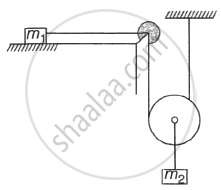Advertisements
Advertisements
प्रश्न
The radius of planet A is half the radius of planet B. If the mass of A is MA, what must be the mass of B so that the value of g on B is half that of its value on A?
उत्तर १
The acceleration due to gravity of a planet is given as
\[\text{g} = \frac{\text{GM}}{\text{r}^2}\]
For planet A:
For planet B:
\[\text{g}_{B} = \frac{\text{GM}_\text{B}}{\text{r}_\text{B}^2}\]
\[\text{g}_\text{B} = \frac{1}{2} \text{g}_\text{A}\] ...(Given) or,
\[\frac{\text{GM}_\text{B}}{\text{r}_\text{B}^2} = \frac{\text{G M}_\text{A}}{2 \text{r}_\text{A}^2}\]
\[\Rightarrow \text{M}_\text{B} = \frac{\text{M}_\text{A} \text{r}_\text{B}^2}{2 \text{r}_\text{A}^2}\]
\[\Rightarrow \text{M}_\text{B} = \frac{\text{M}_\text{A} \text{r}_\text{B}^2}{2(\frac{1}{2} \text{r}_\text{B})^2} = 2 \text{M}_\text{A}\]
उत्तर २
radius of planet ‘A’ = RA, radius of planet ‘B’ = RB
Mass of planet ‘A’ = MA, mass of planet ‘B’ = MB = ?
From given...
`"R"_"A" = ("R"_"B")/2; "g"_"B" = 1/2 "g"_"A"`
`"g" = ("GM")/("R"^2);`
`∴ "g"_"A" = ("GM"_"A")/("R"_"A"^2)`;
`∴ "g"_"B" = ("GM"_"B")/("R"_"B"^2)`
`("GM"_"B")/("R"_"B"^2)`
`("M"_"B")/("R"_"B"^2) = 1/2(("GM"_"A")/(("RB"/2)^2))`
`("M"_"B")/("R"_"B"^2) = 1/2 (4("GM"_"A")/(("R"_"B")^2))`
`"M"_"B" = 2 "M"_"A"`
APPEARS IN
संबंधित प्रश्न
Fill in the following blank with suitable word :
The value of g on the earth is about………………. of that on the moon.
As we go above the earth's surface, value of g increases.
Write scientific reason.
The value of acceleration g is greater at the pole than at the equator.
The mass of a body on the surface of the earth is 10 kg. The mass of the same body on the surface on the moon is `"g"_"m" = 1/6 "g"_"e"`, where gm, ge acceleration due to gravity on the surface of the moon and the earth respectively.
The acceleration due to gravity on a planet is 1.96 m/s2. If it is safe to jump from a height of 3 m on tbe earth, the corresponding height on the planet will be ____________.
The depth 'd' below the surface of the earth at which acceleration due to gravity becomes `(g/n)` is ______.
R = radius of the earth, 'g' = acceleration due to gravity, n = integer
When the value of acceleration due to gravity 'g' becomes `(g/3)` above the earth's surface at height 'h' then relation between 'h' and 'R' is ______.
R =radius of the earth
On the earth, a stone is thrown from a height in a direction parallel to the earth’s surface while another stone is simultaneously dropped from the same height. Which stone would reach the ground first and why?
Suppose the gravity of the earth suddenly becomes zero, then in which direction will the moon begin to move if no other celestial body affects it?
How does the force of attraction between the two bodies depend upon their masses and the distance between them? A student thought that two bricks tied together would fall faster than a single one under the action of gravity. Do you agree with his hypothesis or not? Comment.
The moon has a mass of 1/81 that of the earth and a radius of 1/4 that of the earth. The escape speed from the surface of the earth is 11.2 km/s. The escape speed from the surface of the moon is ______.
A mass attached to one end of a string crosses top-most point on a vertical circle with critical speed. Its centripetal acceleration when string becomes horizontal will be ______. (g = gravitational acceleration)
The value of gravitational acceleration g at a height h above the earth's surface is `"g"/4`, then ______. (R = radius of earth)
The difference in the acceleration due to gravity at the pole and equator is ______.
(g = acceleration due to gravity, R = radius of the earth; θ = latitude, ω = angular velocity, cos0° = 1, cos90° = 0)
If the surface is smooth, the acceleration of the block m2 will be ______.

If the change in the value of g at the height h above the surface of the earth is the same as at a depth x below it, then ______.
(both x and h being much smaller than the radius of the earth)
